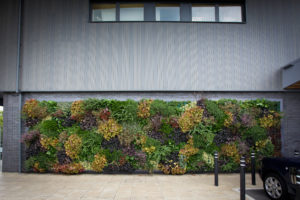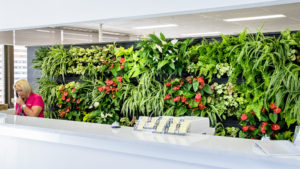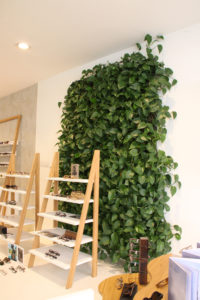

Mobilane install the LivePicture home greenwall system:
“The Mission of Mobilane is to build a greener and healthier environment”
Innovative green systems designed and engineered by Mobilane offer new and exciting possibilities for enhancing spaces, even when there is little space. Building’s walls, both interior and exterior, roof spaces, corridors and meeting spaces offer plenty of scope for adding greenery to contribute to wellbeing and a more pleasing environment. In retail, hospitality, transport, education, government, in fact in almost every sector, there are spaces where our systems are designed to add value.
Carson Arthur of City Line introduces Tracy to a truly innovative green solution, the LivePicture®. He discusses the various uses and explains how it helps with a healthier indoor environment.
Big concrete bollards aren’t exactly what comes to mind when thinking of beautiful urban space design, but according to this article by Universal Magazines, with the release of the Australian Government’s anti-terror deterrent for public spaces, the viability of bollards, seating, planter boxes and other public space infrastructure is taking centre stage in all major cities around Australia.
Anti-Terror infrastructure could incorporate using large plants in planters instead of using those big concrete bollards you’re used to seeing, totally transforming an urban area to one which is both safe and lievable. This is great news for urban space designers and architects because, if you ask us, the bollards themselves aren’t exactly friendly on the eye!
Or our outdoor furniture range
Read more about the Universal Magazine article here
This trial was conducted by Nerida’s Interior Plantscaping, in conjuction with The Container Connection.
The five plant varieties were chosen with the full sun position in mind. The plants generally did well
considering the extreme, north facing location with full sun. I noticed the black cassettes got quite hot and
was worried that the water reservoirs would also heat up and damage the roots that had grown down into
them. Despite this the plants coped well.
Due to the small area the plants are planted into, 7cm tubestock was used. Even with almost a couple of
months to become established before installation, the design looked a little incomplete. Establishing the
plants for 3 months would create more impact for installation.
1. Dwarf Pig face mesembryantheumum – established quickly & is still going strong and added some
interest when flowering. Nice hanging habit. A recommended variety for this greenwall system and an
extreme location.
2. Lomandra confertifolia – seemed to take a while to get established with a couple needing replacing not
long after installation. All are now doing well, the only sign of stress being some browning on the ends
of leaves. Another recommended variety.
3. Carex oshimensis ‘Evergold’ – established quickly & did well overall. Some browning off has recently
occurred and will need cleaning up but new growth is coming through. The spilling habit and green
foliage with a bright yellow streak make this plant an attractive addition.
4. Sedum ‘Dragon’s Blood’ – was selected for its distinctive burgundy foliage but failed to take off. It never
covered up the cassette despite surviving right up until a couple of months ago. Now having mostly died
off, this variety is NOT RECOMMENDED for this greenwall system.
5. Sedum ‘Gold Mound’ – did really well covering up the cassette quickly in a tight clump. A couple of these
plants have now died off but generally still doing well. I think this variety would also work in part shade.
I would definitely use this system again, although for a location like this I would not install again without an
automatic watering system. I found the greenwall needed watering every couple of days over the summer
months. I think the plants may do better with more consistent watering that could be achieved with an automated
system.
Regular feeding with a liquid fertilizer was required to keep plants looking good. I also regularly added a
seaweed solution to help with any stress. When putting together the original design I went with a diagonal pattern. Next time I would put the plants in patches that would make changing one of the panel’s work without messing up the design.
To ‘freshen up’ this greenwall I plan to replace all of the sedum ‘dragon’s blood’ with a hardy flowering
groundcover such as Veronica penduncularis or Erigeron glaucus by planting directly into the cassettes
without removing them. If this isn’t successful perhaps some new cassettes will be needed to start over.
The story behind One Central Park starts with two artists who shared the same vision; architect Jean Nouvel, and French artist and botanist Patrick Blanc. One Central Park offered Nouvel and Blanc a canvas of an entirely new scale. Here they built an integrated experience for living in harmony with the natural world – That’s where we came in!

We were lucky enough to be able to showcase a huge number of The Container Connection’s Greenwalls in this design, which was achieved by building thousands of low profile troughs into the great structure you see today. These were made to incredibly high architectural standards, in order to withstand the elements and to fit in with all of the other engineering required in a high rise sustainable building such as One Central Park in Sydney. The image attached is a view of the pop up external terraces that have our purpose built low profile planters and are working incredibly well.
“Landscape is architecture,” declares Nouvel. “Here we have created a continuity so the façades extend the park into the sky”
The latest report to Interior Plantscape Association from Plants and Urban Air Quality Group, School of Life Sciences, University of Technology Sydney (UTS), titled ‘Towards Development of Indoor Plant Walls for Improved Indoor Air Quality’ has been released. This study, although preliminary, contributes to the baseline scientific information needed for the development of indoor plant-walls and other living-green installations.

Carbon Dioxide Reductions
Excess CO₂ causes drowsiness with levels in higher concentrations indoors, mainly from occupants’ breathing but also from any non-flued gas appliances.The study found that plant walls have the ability to reduce Co2 levels from 13 percent up to 23 percent, when provided with adequate lighting, therefore having significant benefits to the health, wellbeing and productivity of occupants.

Airborne Particulate Matter Reduced
The study also suggests there was a trend towards reductions of extremely fine airborne particulate matter (PM) in urban areas, including inside commercial or other buildings. PM is emitted from fossil fuel combustion, which mixes with natural dust etc, causing city haze. These ultra fine particles are known to be a serious health hazard. Lung and cardiovascular disease, and well as the increasing incidence of autism, have been linked in particular with levels of airborne particulate matter.

Importance of Findings
With 80% of the Australian population living in urban areas and spending about 90% of our time indoors, the ability of plant walls to reduce levels of all types of indoor air pollutants has significant advantages. The use of any living-green installations to refresh indoor air in air-conditioned city buildings could also reduce the energy load on the building, and its footprint, contributing to the goal of urban sustainability.
“This study is important since it reinforces previous studies demonstrating the benefits of indoor plants and gives us a clear direction for future research,” Prof. Margaret Burchett from UTS Plants and Urban Air Quality Group said.“It is clear that investing in indoor greenery and plant walls more than repay the costs in terms of occupant well-being and performance so investigating the most effective methods of incorporating plant walls makes sense.”
The Interior Plantscape Association and UTS would like to thank the previous New Zealand Association PAWA (Plants At Work Association) for funding this Indoor Plant Walls project and Mr Jock Gammon, Junglefy Pty, Ltd., for providing access to the plant-wall installations studied.
For further information please contact Prof. Margaret Burchett from the research team at the Plants and Urban Air Quality Group School of Life Sciences, University of Technology Sydney, Margaret.burchett@uts.edu.auNerida Hills, Interior Plantscape Association President thepresident@interiorplantscape.asn.au or visit ipa.asn.au
Leersum, 6 June 2016 – The front wall of recently opened European distribution centre in the Belgian community of Laakdal, from world’s largest manufacturer of sports shoes, is growing the largest green wall of Europe. The green wall surface consists of just under 100,000 plants spanning over 2,000 m2. The applied green wall system, LivePanel, consists of a carefully selected range of plants, including Alchemilla, Bergenia, Campanula, Geranium and Nepeta. The innovative new building of the leading sports brand is powered by fully renewable energy from solar panels, wind turbines and a geothermal system.
Saving water
BSI Bomenservice, based in Baarn, is responsible for installation and maintenance. The giant planted wall is equipped with an integrated irrigation system, permanently distributing enough moisture and plant food. “The client required a sustainable green wall with minimum water consumption. After an extensive selection process of available systems, we chose Mobilane’s LivePanel in consultation with the architects. The minimal water consumption, the relatively low weight and the proven performance of the green wall system in combination with the excellent quality/price ratio were the key factors,” say Mobilane and BSI Bomenservice.
Innovative
The plant wall consists of Mobilane’s modular LivePanel system. Mobilane is a supplier of innovative green systems. The green wall is not soil-bound and contains a total of 11,000 exchangeable plant cassettes. Each row of cassettes is placed in an aluminium duct profile which also serves as a water reservoir. The plants in the cassettes are automatically watered by an innovative capillary irrigation system operated by wall sensors. The innovative system requires little maintenance, is leak-free and not susceptible to breakdowns. Once disassembled, the living wall can be recycled in full.
Exclusive to TCC in Australia and New Zealand.
Mobilane, part of The Darthuizer Group in the Netherlands, had the benefit of over 80 years horticultural experience with its nursery when it developed Green Screen in 2001, then progressed to LivePanel in 2010. LivePicture was then developed in 2013. Mobilane products are now available in more than 35 countries including Australia and New Zealand, a testament to their innovation, experience and passion to the green industry.
The Container Connection (TCC) group was approached by Mobilane to represent their products in Australia and New Zealand. With branches in every state of Australia and in Wellington New Zealand TCC are proud to take these innovative products to you and the market.
LivePicture – a living picture made up of plants embodies innovation and design to deliver stunning effects. LivePicture can be easily and quickly mounted on any wall using the kit provided. The frame includes an integrated watering system with reservoir to ensure that the plants are provided with water for four to six weeks. The innovative-patented construction requires no electric power. Live Picture is a space saving solution for interior environments. LivePicture is available in a number of sizes and standard colours. Other colours can be arranged on application.
LivePanel brings your walls to life – an innovative vertical landscaping application that delivers a sustainable ‘living wall’ system for both indoor and outdoor use. With the benefit of Mobilane’s eight decades of landscaping experience this unique system has been developed for green facades. Living walls are very popular, not only in the commercial environment such as offices, shops and public spaces, but also increasingly for residential use.
With LivePanel, you can take the outdoors inside and bring your walls to life. The system easily transforms your wall into an attractive, living surface. LivePanel is a modular living wall system with exchangeable plant cassettes. The cassettes consist of cups in which plants are inserted. Each row of cassettes is placed in a duct profile that also serves as a water reservoir. The plants absorb water from the duct through a capillary system.
LivePanel can be used for various vertical, landscaping applications. Let your creativity flow with the design options that the system offers. LivePanel can be easily installed on new or existing walls.
Plants make an important contribution to the indoor climate, through their production of oxygen, purification of the air and positive effect on relative humidity. Scientific research has shown that anyone who spends more than four hours per day in a room with plants will find it more pleasant and will be demonstrably more productive. There’s no better way to include plants in your workplace or home then using LivePicture or LivePanel.
The Limbo LED was a key feature at the Sydney Opera House during the VIVID Light festival. As a vantage point for the light-show on the Harbour, the Limbo provided functional seating while illuminating the surrounding area with gentle colours.
For more information, about this illuminated furniture contact your local Container Connection office.
By sourcing Australian owned and manufactured products, you access readily available parts, on-time deliveries, exceptional product warranty and market competitiveness based on quality.
Well laid out seating, planters for screening and clearly marked litter management stations are simple ways to demarcate the function of different areas and direct people to the proper use of your spaces.
The Container Connection are uniquely positioned to help you respond to global trends with local solutions.
